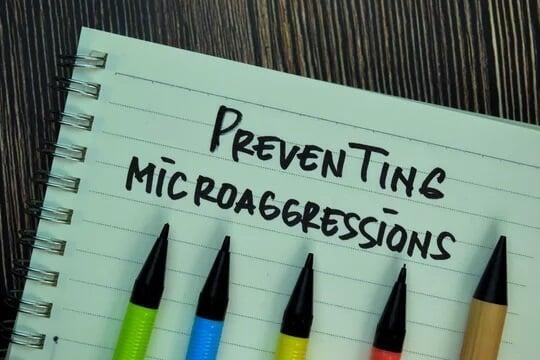Let's be Candid - Series 2
Let's be Candid - Series 2
Identifying and addressing microaggressions:
Often when a verbal microaggression is made, the perpetrator could be talking in a friendly way, even smiling, and the microaggression is casually dropped in the conversation. The person on the receiving end might have a first response to laugh or might feel uncomfortable but carry on and ignore it. If given the opportunity to reflect on what has happened, the individual might realise it was leaning into a stereotype, inflicting a harmful type of discrimination. It might only dawn on them afterwards that it wasn’t right. This can be difficult to deal with, as people often feel like the opportunity to address what happened has passed and it’s not important anymore, so they don’t raise it.
Microaggressions can accumulate quickly, because the first time it might feel awkward, and the second time it is more uncomfortable. A third party who witnessed the conversation might check in to see if the person affected is OK because they noticed the microaggression. Sometimes having another party confirm what happened can be reassuring, especially if the victim didn’t want to admit to what transpired.

Calling out microaggressions
To be honest, it may be hard to call out someone that is being microaggressive, and it may not be possible to address the situation immediately when the microaggressive statement or act is made as there may be others present or the person being microaggressive is an older colleague. The time may not be right bit this does not change the fact that microaggressions are harmful.
We take a few pointers from Lorna Hollowood, a lecturer in nursing who recommends that addressing microaggressions and calling out the perpetrator, should be done politely and in a non-confrontational manner, but also from a place of empowerment. One good way to do this is to not respond or answer to the microaggression, but to interrogate their value system. Try saying “What do you mean by that?” or “What made you say that?”
Here's an example. If someone says: “You’re so articulate, you speak so well for someone from where you’re from”, you can clearly see the bias - for someone from where you’re from, this is not a true compliment. Don’t try to justify your speaking prowess by explaining how you’ve studied for so many years and had speaking opportunities. Instead, say: “That’s an interesting thing to point out, what made you say that?”
Probe the person to think about where that question came from. Using his technique will feel empowering, it may create an awkward moment, but such underhand complements will be reduced. The approach is non-confrontational, it is not offensive way and it gives a person that should feel slighted the driving seat.
Introspection
How can you stop yourself from displaying microaggressions:
- Reflect on your biases: Awareness of your own biases is crucial. Reflect on your assumptions, stereotypes, and stereotypes you may hold about certain groups. Some of these may be unconscious biases so it’s good to really take time with this reflection.
- Educate yourself: Seek out resources, literature, and training about diversity, inclusion, and unconscious bias to gain a deeper understanding of the experiences and challenges faced by marginalised groups.
- Practice empathy and active listening: Listen without judgment, seek to understand other perspectives, and empathise with experiences different from your own.
- Be respectful and mindful: Think before you speak or act and consider how your words or actions may affect others. Respect others' cultural values and norms.
- Apologise and learn: If you recognise that you have displayed a microaggression, apologise to the affected individual and commit to learning and improving your behaviour.
Within your professional circle, you may have identified colleagues in your organisation or team demonstrating microaggressions. How can these be handled in the workplace?
- Education and awareness: Organisations should provide training and workshops on unconscious bias, diversity, and inclusion to help employees recognise and understand microaggressions. If microaggressions are pervasive but not being addressed in your organisation, point it out to your human resources team and volunteer to help with the required education and awareness.
- Encouraging open communication: As a manager or team member, create an environment where people feel safe to address microaggressions by providing or insisting on a channel to report incidents and a clear process for addressing them.
- Promote cultural sensitivity: Educate yourself and encourage people around you to educate themselves about different cultures, backgrounds, and experiences to develop empathy and understanding.
- Foster accountability: Hold individuals responsible for their actions by implementing (or requesting the organisation to implement) policies and guidelines against discrimination, with repercussions for offenders. You don’t have to be confrontational, but we all have a responsibility to call out microaggressions in the workplace
- Diverse and inclusive leadership: If within your capacity, promote diverse leadership at all levels of the organisation, as this helps to set the tone and establish norms that discourage microaggressions.
Addressing and eliminating microaggressions requires the collective effort of individuals, teams, and organisations, where awareness, education, empathy, and strong inclusive leadership play a crucial role. Regardless of if opportunity has been created or not, we should be accepting of those around us and it would be great to make our little corners of the world more tolerable for others,
©Foluke Fadare
The initial part of this blog - Unwittingly Serious Stuff is available as a blogpost on TLHub.Online

